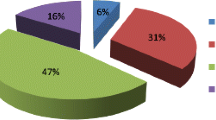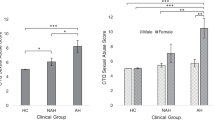Abstract
Objective
Numerous studies of both clinical and large-scale population based samples have demonstrated that adverse childhood events are risk factors for subsequent psychosis. This study assessed the relationships between adverse childhood events and auditory and visual hallucinatory experiences.
Method
The study analysed data from the National Comorbidity Survey Replication conducted in the US that assessed (all before age 16) rape, sexual assault and physical assault. Psychosis symptomatology was represented by lifetime experience of auditory and visual hallucinations. Control variables included gender, age, urbanity, ethnicity, marital status, education, employment status, alcohol dependence and drug dependence.
Results
All three adverse events were significantly related to both types of hallucinations. Those who had been raped as children were 3.3 times more likely to have experienced visual hallucinations and 3.5 times more likely to have experienced auditory hallucinations compared to those who had not been raped in childhood. Both rape and physical assault significantly predicted visual and auditory hallucinations. A significant dose–response relationship was also found.
Conclusions
Previous findings indicating that adverse events in childhood may be causally related to subsequent psychosis are supported. The psychological and biological mechanisms underlying the relationship are already the subject of investigation. Repeated recommendations concerning routine enquiry about adverse experiences in childhood in order to facilitate comprehensive formulations and appropriate treatment, also receive support from these findings.
Similar content being viewed by others
References
Read J, Bentall R, Fosse R (2009) Time to abandon the bio-bio-bio model of psychosis: exploring the epigenetic and psycholgocial mechanisms by which adverse life events lead to psychotic symptoms [Editorial]. Epidemiol Psichiatr Soc 18:299–317
Read J, Fink P, Rudegeair T, Felitti V, Whitfield C (2008) Child maltreatment and psychosis: a return to a genuinely integrated bio-psycho-social model. Clin Schizophr Relat Psychoses 2:235–254
Morgan C, Fisher H (2007) Environmental factors in Schizophrenia. Childhood Trauma—a critical review. Schizophr Bull 33:3–10
Bendall S, Jackson HJ, Hulbert CA, McGorry PD (2008) Childhood trauma and psychotic disorders: a systematic, critical review of the evidence. Schizophr Bull 34:568–579
Read J, Gumley A (2008) Can attachment theory help explain the relationship between childhood adversity and psychosis? Attachment 2:1–35
Read J, van Os J, Morrison A, Ross C (2005) Childhood trauma, psychosis and schizophrenia: a literature review with theoretical and clinical implications. Acta Psychiatr Scand 112:330–350
Bebbington P (2009) Childhood sexual abuse and psychosis: aetiology and mechanism. Epidemiol Psichiatr Soc 18:284–293
Janssen I, Krabbendam L, Bak M, Hanssen M, Vollebergh W, de Graaf R, Van Os (2004) Childhood abuse as a risk factor for psychotic experiences. Acta Psychiatr Scand 109:38–45
Conus P, Cotton S, Schimmelmann B, McGorry P, Lambert M (2009) Pretreatment and outcome correlates of sexual and physical trauma in an epidemiological cohort of first-episode psychosis patients. Schizophr Bull. doi:10.1093/schbul/sbp009
Fisher H, Morgan C, Dazzan P, Craig T, Morgan K, Hutchinson G, Jones PB, Doody GA, Pariante C, McGuffin P, Murray RM, Leff J, Fearon P (2009) Gender differences in the association between childhood abuse and psychosis. Br J Psychiatry 194:319–325
Shevlin M, Dorahy MJ, Adamson G (2007) Childhood traumas and hallucinations: an analysis of the national comorbidity survey. J Psychiatr Res 41:222–228
Kessler RC, Merikangas KR (2004) The national comorbidity survey replication (NCS-R): background and aims. Int J Method Psychiatr 13:60–68
Kessler RC (1994) The national comorbidity survey of the United States. Int Rev Psychiatr 6:365–376
Kessler RC, Ustun TB (2004) The world mental health (WMH) survey initiative version of the world health organization (WHO) composite international diagnostic interview (CIDI). Int J Methods Psychiatr Res 13:93–121
Leung A, Chue P (2000) Sex differences in schizophrenia, a review of the literature. Acta Psychiatr Scand 401:3–38
Moskowitz A, Schäfer I, Dorahy M (2008) Psychosis, trauma and dissociation: emerging perspectives on severe psychopathology, Wiley Press
Larkin W, Morrison A (2006) Trauma and psychosis: new directions for theory and therapy, Routledge
Read J, Mosher L, Bentall R (2004) Models of madness: psychological, social and biological approaches to schizophrenia. Brunner-Routledge, Hove, UK
Freeman D, Garety PA, Kuipers E, Fowler D, Bebbington PE (2002) A cognitive model of persecutory delusions. Br J Clin Psychol 41:331–347
Kilcommons AM, Morrison A (2005) Relationships between trauma and psychosis: an exploration of cognitive and dissociative factors. Acta Psychiatr Scand 112:351–359
Read J, Perry BD, Moskowitz A, Connolly J (2001) The contribution of early traumatic events to schizophrenia in some patients: a traumagenic neurodevelopmental model. Psychiatry 64:319–345
Gilmore J (2010) Understanding what causes schizophrenia: a developmental perspective. Am J Psychiatry 167:8–10
van Os J, Linscott RJ, Myin-Germeys I (2009) A systematic review and meta-analysis of the psychosis continuum: evidence for a psychosis proneness-persistence-impairment model of psychotic disorder. Psychol Med 39:179–195
Murphy J, Shevlin M, Houston J, Adamson G. A population based analysis of sub-clinical psychosis and help-seeking behaviour. Schizophr Bull. doi:10.1093/schbul/sbq092
Read J, Hammersley P, Rudegeair T (2007) Why, when and how to ask about child abuse. Adv Psychiatr Treat 13:101–110
Fisher H, Craig T, Fearon P, Dazzan P, Lappin J, Hutchinson G, Doody G, Jones P, McGuffin P, Murray R, Leff J, Morgan, C. Reliablity and comparability of psychosis patients’ retrospective reports of childhood abuse. Schizophr Bull. doi:10.1093/schbul/sbp103
Martin J, Mullen P, Romans S, Herbison P (1993) The prevalence of childhood sexual abuse experiences in a community sample of women. J Am Acad Child Psychiatry 32:911–919
Shevlin M, Dorahy MJ, Adamson G (2007) Trauma and psychosis: an analysis of the national comorbidity survey. Am J Psychiatry 164:166–169
Bebbington PE, Bhugra D, Brugha T, Singleton N, Farrell M, Jenkins R, Lewis G, Meltzer H (2004) Psychosis, victimisation and childhood disadvantage: evidence from the second British National Survey of Psychiatric Morbidity. Br J Psychiatry 185:220–226
Johns LC, Nazroo JY, Bebbington P, Kuipers E (2002) Occurrence of hallucinatory experiences in a community sample and ethnic variations. Br J Psychiatry 180:174–178
Johns LC, Cannon M, Singleton N, Murray R, Farrell M, Brugha T, Bebbington P, Jenkins R, Meltzer H (2004) Prevalence and correlates of self-reported psychotic symptoms in the British population. Br J Psychiatry 185:298–305
Spauwen J, Krabbendam L, Lieb R, Wittchen H, van Os J (2006) Impact of psychological trauma on the development of psychotic symptoms: relationship with psychosis proneness. Br J Psychiatry 188:527–533
Scott J, Chant D, Andrews G, Martin G, McGrath J (2007) Association between trauma exposure and delusional experiences in a large community-based sample. Br J Psychiatry 190:339–343
Loranger AW (1984) Sex difference in age at onset of Schizophrenia. Arch Gen Psychiatry 41:157–161
van Os J, Hanssen M, Bijl RV, Ravelli A (2000) Strauss (1969) revisited: a psychosis continuum in the general population? Schizophr Res 45:11–20
Johns LC, van Os J (2001) The continuity of psychotic experiences in the general population. Clin Psychol Rev 21:1125–1141
Shevlin M, Murphy J, Dorahy MJ, Adamson G (2007) The distribution of positive psychosis-like symptoms in the population: a latent class analysis of the National Comorbidity Survey. Schizophr Res 89:101–109
World Health Organization (1973) International pilot study of schizophrenia, Geneva
Schneider K (1959) Clinical psychopathology. Grune & Stratton, New York
Author information
Authors and Affiliations
Corresponding author
Rights and permissions
About this article
Cite this article
Shevlin, M., Murphy, J., Read, J. et al. Childhood adversity and hallucinations: a community-based study using the National Comorbidity Survey Replication. Soc Psychiatry Psychiatr Epidemiol 46, 1203–1210 (2011). https://doi.org/10.1007/s00127-010-0296-x
Received:
Accepted:
Published:
Issue Date:
DOI: https://doi.org/10.1007/s00127-010-0296-x




